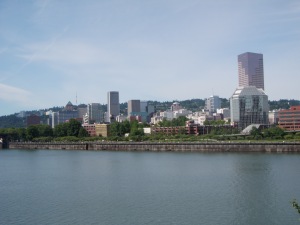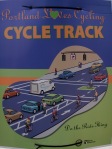Building a Bike Friendly City
 “Can you see that big bird over the river? It’s either a bald eagle or an osprey.” I was overlooking the Willamette river with Councilor Rex Burkholder, from the Metro regional government, listening as he explained to me the changes made in the last few decades to the waterfront. “We’re seeing more bald eagles around Portland – they have made a great comeback from when I was a kid.”
“Can you see that big bird over the river? It’s either a bald eagle or an osprey.” I was overlooking the Willamette river with Councilor Rex Burkholder, from the Metro regional government, listening as he explained to me the changes made in the last few decades to the waterfront. “We’re seeing more bald eagles around Portland – they have made a great comeback from when I was a kid.”
The same could be said about biking in Portland. Fifteen years ago, biking here was not much better than in other American cities. Now, bikes are an important part of the transportation strategy for the city. So the bald eagle and the bicycle are both thriving here along the Willamette.
After 5 days in Portland, I can already see that cities can be transformed to include bikes as an important way to get around. Back home in Denver, it can feel like this is an impossible task. But Portland cries out: Take heart! It can be done!
I have had some great conversations with various players in the Portland bike transportation world including Rob Burchfield, City Traffic Engineer; Mark Lear, City Safety Program Manager; Mia Birk, CEO & Principal at Alta Planning & Design (along with her colleagues); Councilor Rex Burkholder of the metro regional government and staff; and Dr. Jennifer Dill from Portland State and IBPI. They have all shared their view of the transformation of Portland. It’s clear there are different domains or facets of the bike movement that need to be nurtured and grown in order for the transformation to succeed. I have listed my summary below. Look for a new book by Mia Birk of Alta Planning & Design that is coming out this fall that will explain how to make this transformation of our cities.
So what are the components?
Vision: A clear, bold plan for what the city wants to become is needed. These plans should challenge us to make an important transformation and not be incremental.
Leadership: Leaders in the city and elected officials need to continue to drive the change even when it gets hard to support it. Just as important as the elected officials is the city staff – are they supportive of bike and pedestrian transportation?
Demonstration Sites: Cities need to show what this could look like. Find a visible place for transformation and  show off the active transit use that it creates.
show off the active transit use that it creates.
The Hard Stuff (roads, intersections, trails): There’s no getting around it – the city has to invest in the infrastructure of road and intersection improvements. But it is an investment, which will pay back dividends. Building bikeways is much less expensive than building new roads. So a commitment of money is required.
Strong Bike Advocacy Groups: Since the leadership and the money are not often committed to bike transit in our current state, our citizens need to ask – sometimes loudly – for these resources. Organized advocacy groups also help support the politicians and city staff by providing them cover: the city planners and engineers are more likely to invest in a major transformation if there are crowds of citizens requesting this at city council meetings.
 Measurement: Are we making progress? Where are we now? Being able to demonstrate progress through measures is required. Bike counts with “tube counters” over the bridges here in Portland have demonstrated increase ridership over the years, and this has in turn made for a great graphic or chart that politicians can use to further their bike transit efforts.
Measurement: Are we making progress? Where are we now? Being able to demonstrate progress through measures is required. Bike counts with “tube counters” over the bridges here in Portland have demonstrated increase ridership over the years, and this has in turn made for a great graphic or chart that politicians can use to further their bike transit efforts.
Origins & Destinations (Land Use): I first heard this phrase in Seattle, where bike ridership improved when the infill development of downtown occurred. People need destinations that are close to where they live if they are going to consider biking as an alternative transportation mode. This can be particularly challenging in the suburbs, where you typically need to drive to destinations.
One More Cyclist: Even if you build a bike friendly city, transforming a person from someone who hasn’t ridden a bike since childhood into a citizen who is willing to ride their bike often requires hands-on support. This is hard, human intensive work. Can a current cyclist help mentor, coach and model bike use to another? Help them with the basic questions of what streets to ride, how to wear a helmet, how to bike safely. This is increasing bike mode share one more cyclist at a time.
Of course, you also need the long view! Just as it has taken 40 years to see the success of our nation’s efforts to save the bald eagle, so too will it take 15+ years before we’ll see serious change in the bikability of our communities. But it can be done! Portland is the proof!
Explore posts in the same categories: Uncategorized
Leave a comment